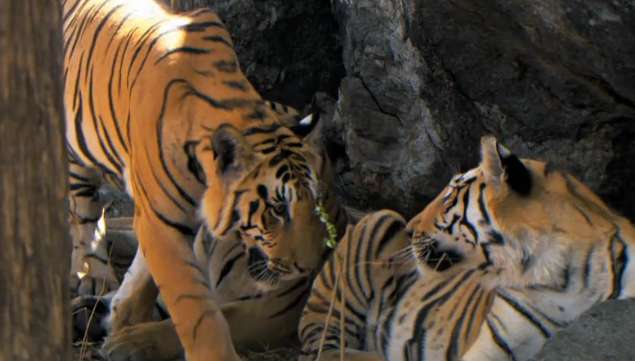Tiger is the top predator in nature. We have all heard more or less about tigers since childhood. One of the common views is that male tigers are extremely irresponsible fathers. After the female tiger is pregnant, He just walked away and did not participate in the subsequent parenting process at all.
In fact, this is indeed the case, but it is not that the male tiger took the initiative to leave. The real situation is that it was forced to leave by the female tiger. During the estrus period, the male and female live together, but when the female tiger becomes pregnant, her attitude will undergo a two-level reversal, and she will start to become sensitive and irritable, and will give the male tiger looks from time to time. So at this time, the male tiger is also very sensible and chooses to leave silently.

As we all know, single mothers want to It is not easy to raise children, and many male individuals in nature do not participate in the child-rearing process. Tigers are a typical example.
After the female tiger is pregnant and leaves, the male tiger does not participate in the raising process, and almost does not help at all. It depends entirely on the female tiger to raise the cubs. So how does a single female tiger raise the cubs? What about the big cub?
Research has found that a female tiger will undergo many changes after becoming a mother. Among them, there are three change strategies that can help the female tiger easily cope with the entire parenting stage.
Farewell to no fixed abode for now
Tiger is a large cat with significant exploratory behavior and high mobility. They live in no fixed abode and usually do not have a fixed nest. , you can rest almost wherever you go.
However, during the period from when the tigress is about to give birth to when her cubs grow up and leave, they will temporarily say goodbye to their days of no fixed abode and start living a settled life. Tigresses don't show their belly in the early stages of pregnancy, so they are no different at this stage than when they were single.
In the last 3-5 days before giving birth, the tigress will choose a safe place in the territory and build a simple nest to serve as the delivery room and the main living place for the cubs. .
Tigers are very alert animals, so they build more than one den, usually 3-5, of which one is the main den and the rest are temporary residences.
I believe many people have heard the allusion of "Meng's mother moved three times", mainly to give her children a good growing environment. Tigers will also migrate many times during the process of raising their babies, mainly for safety reasons.
Newborn tiger cubs are very fragile, and many ferocious beasts in nature can easily kill them. Therefore, when the mother tiger thinks that the place is unsafe, she will quickly take the cubs with her.Move to another nest to effectively protect the safety of the pups.

The action efficiency is greatly improved< /p>
Scientists once tracked and studied a female tiger named "Vavala" and found that her usual range of activities was about 500 square kilometers. After she became pregnant and gave birth to tiger cubs, her range of activities expanded. It was suddenly reduced to about 180 square kilometers, and its activity range was almost always centered on the nest.
As a mother, "Wavala" also moves much faster. It may take 20 minutes to go back and forth between the hunting site and the nest, but it may only take 15 minutes to raise her babies.
Especially within two months after the tiger cubs are born, the tiger cubs are highly dependent on the mother tiger, so the mother tiger's action efficiency will be greatly improved during this period.
It can be seen from the fact that the tigress's range of activities is centered on the nest. After becoming a mother, all the focus of the tigress's life is on her cubs. She reduces her range of activities and improves her cubs. The purpose of action efficiency is to reduce the time away from the cubs and free up more free time to stay with the cubs.
Adult tigers have no natural enemies, but young tigers are extremely vulnerable to threats from leopards, jackals, bears, lynxes and other predators, so this change in the mother tiger's strategy is very important.
In addition, in order to ensure that prey can still be protected when the activity range is reduced and the time outside is reduced, the tigress will choose an area with rich prey resources as early as when she is pregnant and building a nest. .
The predatory strategy is more aggressive
About the first 8 weeks after birth, the digestive system of tiger cubs is not yet mature, so their main food source at this stage is the mother tiger’s milk. .
Tigresses in the nurturing stage need to ensure a sufficient supply of milk, so their food intake will increase by about 50% than before. This means that during the nurturing stage, the tigress will have to capture more Lots of prey.
It is said that female tigers are more ferocious. This is not without reason. In order to obtain more food, female tigers in the nurturing stage will be more aggressive in their hunting strategies and are more willing to try to capture them. Prey that are larger and more difficult.
The change in hunting strategy is foreseeable. First of all, the tigress in the raising stage has less time to go out, and the range of activities is narrower. Only by capturing larger prey can the other neckbands be supplemented. coming losses.
Tigers are very alert predators. A study based in the Sikhote MountainsResearch has found that the Siberian tiger's prey preferences are mostly medium-sized prey such as red deer, wild boar, and roe deer, and the weight basically does not exceed 200 kilograms.
However, in the research of "Vavala", it was found that once the female tiger is in the nurturing stage, the size of the prey captured will be significantly larger than usual.
I have to say that the tigress, a single mother, is still very great. Without any help from the male tiger, she can easily cope with the entire process of raising cubs with just three strategic changes. A litter of tiger cubs is raised.
On average, tiger cubs have the ability to survive on their own when they are one and a half years old, but at this time they are not eager to leave the mother tiger, but will continue to live with the mother tiger for a period of time. Strengthen your body while also consolidating your survival skills.
In about two years, the tiger cubs will leave the mother tiger, which also marks the end of the mother tiger's cub-raising process.